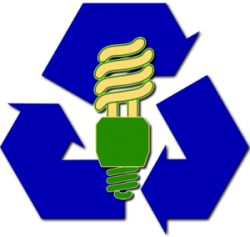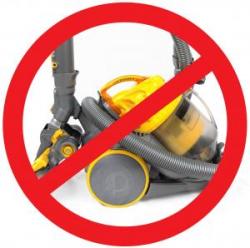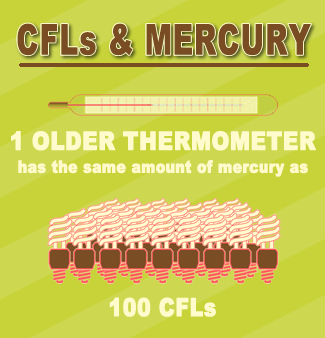What Should I Do With A Broken CFL?
Compact fluorescent light bulbs have a lot of benefits. They use less energy and, therefore, can help you save money. But there are a few important things to be aware of when it comes to disposing of and cleaning up CFLs.
![]()
Compact fluorescent light bulbs have a lot of benefits. They use less energy and, therefore, can help you save money. Saving energy also means that we can all enjoy cleaner air. CFLs also reduce the number of light bulb changes, so they are especially great for those hard-to- reach places.
But there are a few important things to be aware of when it comes to disposing of and cleaning up CFLs.
![]()
CFLS Contain Hazardous Material
Fluorescent lights contain mercury, which can present safety concerns if not managed properly. Small amounts of mercury can be released into the environment when CFLs break, or if they are improperly disposed of at the end of their useful lives.
![]()
Why Use CFL’s If They Contain Mercury?
The amount of mercury in a CFL is very small and is part of what allows the bulb to be energy efficient. By comparison, an old thermometer contains 500 milligrams of mercury—which is equal to the amount of mercury in over 100 CFLs.
Despite the small amount of mercury, CFLs help reduce our overall environmental impact because of their significant energy savings.
![]()
Recycling Is The Best Option For CFLS
When thrown in a dumpster or trash can, fluorescent bulbs often break, releasing mercury into the environment. Recycling CFLs prevents the release of mercury into the environment. Virtually all components, glass, metals, and other materials, of a fluorescent bulb can be recycled.
It is critical that the bulbs arrive unbroken to recycling centers. So prior to recycling them, put fluorescent bulbs in packaging that prevents them from breaking, such as their original boxes, boxes from replacement bulbs, or containers supplied by fluorescent light bulb recyclers.
![]()
 Finding a Recycler
Finding a Recycler
There are numerous options for recycling CFLs. The TCEQ maintains a list of household hazardous waste disposal and recycling options—because CFLs contain mercury, they are considered HHW. Search lamprecycle.org for recycling choices in your zip code. Contact your local solid waste services department to ask if there is an HHW facility in your area. The EPA has information about services that accept CFLs for recycling by mail.
![]()
Cleaning Up A Broken Bulb
The EPA has suggestions to help you prevent broken CFLs. However, even careful handling can result in breaks. The following steps are best practices for cleaning up a CFL. Don’t be alarmed if you don’t do it right—the amount of mercury in a CFL is very small—just try to follow these precautions. The first things that you want to do before cleaning up are:
- have people and pets leave the room, avoiding the breakage area,
- open a window and leave the room for five to ten minutes,
- shut off your central heat/air system if you have one, and
- gather the materials you will need clean up the broken bulb such as stiff paper or cardboard, sticky tape, damp paper towels, a glass jar with a metal lid or a sealable plastic bag*.
*Note that a plastic bag will not prevent the mercury from escaping, so you should remove the plastic bag from your home after clean up.
![]()
How to Clean Up the Bulb Fragments
Scoop up glass fragments using the stiff paper or cardboard and put the debris and paper/cardboard in a glass jar or plastic bag. Use sticky tape to pick up any remaining glass fragments and powder. Place the tape in the plastic bag. Wipe the area with damp paper towels and then place the towels in the jar or plastic bag. Place all bulb debris and cleanup materials outdoors in a trash container or protected area until materials can be disposed of. Then, wash your hands with soap and water. Continue to air out the room where the bulb was broken and leave the HVAC system off, as practical, for several hours.
![]()
 Vacuuming is Not Recommended
Vacuuming is Not Recommended
Vacuuming of hard surfaces, carpeting, or rugs is not recommended unless broken glass remains after all other cleanup steps have been taken. If you do need to vacuum to ensure all broken glass is removed, keep the following in mind:
- Keep a window open.
- Use a vacuum hose if available.
- Remove the vacuum bag or empty and wipe the canister, and seal the bag, debris, and any material used to clean the vacuum in a plastic bag.
- Put the plastic bag outdoors in a trash can or protected area until the materials can be disposed of.
![]()
Running the Vacuum in the Future
The next several times that you run the vacuum where the bulb was broken, shut off the HVAC system, close the doors to other rooms, and open a window. Change the vacuum bag after each use. After vacuuming, keep the HVAC system shut off and the window open, as practical, for several hours.
![]()
Disposing of a Broken Bulb
Keep the broken bulb in its jar or bag outside in a trash can or protected area until the materials can be disposed of. Check the TCEQ list or Earth911 for disposal options. Contact your local government about disposal requirements and options in your area.
Learn more about saving energy by using efficient bulbs.







